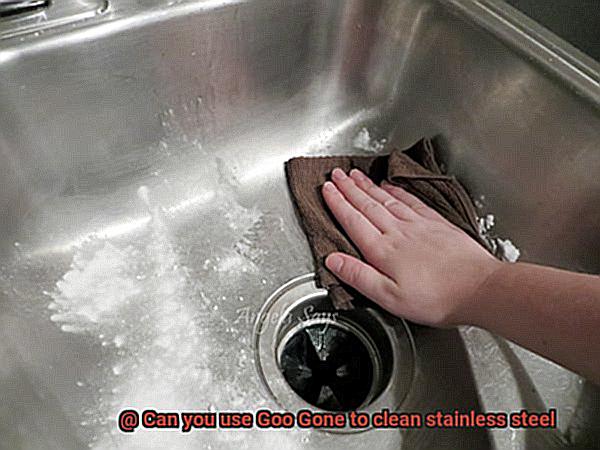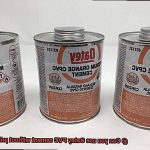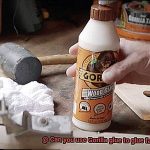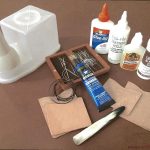Stainless steel, oh how it shines. But let’s be real, keeping it that way is no easy feat. Fingerprints, smudges, and stubborn stains seem to have a knack for finding their way onto its sleek surface. Well, fear not my friends, because today we’re about to unveil a hidden gem that could change your stainless steel cleaning game forever.
Ever wondered if Goo Gone, the adhesive remover extraordinaire, holds the key to restoring your stainless steel’s brilliance? Buckle up as we dive deep into this intriguing question and unlock the untapped potential of Goo Gone for stainless steel cleaning.
In this all-inclusive guide, we’ll explore the power of Goo Gone – a trusted household name – when pitted against those pesky blemishes on your stainless steel surfaces. Can it effortlessly banish them, bring back lost luster, and leave your stainless steel gleaming like new? Stick around my friend; we’re about to find out.
From practical tips to foolproof techniques, we’ll spill all the beans on using Goo Gone with your precious stainless steel. Worried about potential damage or compatibility issues with different finishes? Don’t fret. We’ve got you covered with step-by-step instructions for achieving jaw-dropping results.
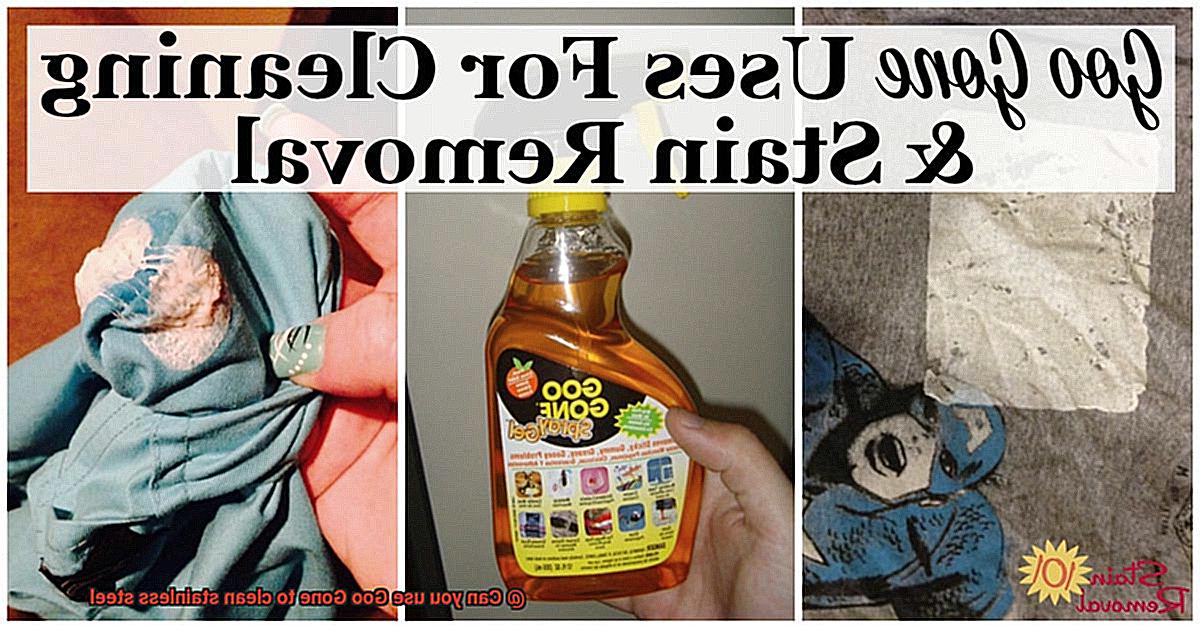
So whether it’s your trusty fridge that needs a makeover or those glamorous countertops that deserve some TLC, get ready for a game-changer in your cleaning arsenal. Say hello to Goo Gone and say goodbye to dull stainless steel. It’s time to shine bright like a diamond.
What are the Properties of Stainless Steel?
Contents
- 1 What are the Properties of Stainless Steel?
- 2 How Does Goo Gone Work?
- 3 Is it Safe to Use Goo Gone on Stainless Steel Surfaces?
- 4 Testing Goo Gone on a Small Area of Stainless Steel Surface
- 5 Steps for Cleaning Stainless Steel with Goo Gone
- 6 Tips for Using Goo Gone on Stainless Steel Surfaces
- 7 Potential Damage to Stainless Steel from Using Goo Gone
- 8 Alternative Cleaning Methods for Stainless Steel
- 9 Conclusion
Stainless steel, a material recognized for its durability, resistance to corrosion, and captivating appearance, holds a prominent place in various industries. From construction to food processing, its versatile applications make it essential to understand the properties of stainless steel thoroughly. In this article, we will explore the fascinating properties of stainless steel and unravel the mystery surrounding its compatibility with the popular cleaner, Goo Gone.
Corrosion Resistance: A Fortress Against Decay
The exceptional resistance to corrosion is undoubtedly one of the most remarkable properties of stainless steel. The addition of chromium in stainless steel gives birth to a protective shield, aptly named the passive film. This ultra-thin barrier acts as a stalwart guardian, warding off oxidation and thwarting rust formation. By virtue of this property, stainless steel emerges triumphant in different environments, including high-humidity or outdoor settings.
High Strength: A Pillar of Endurance
The reputation of stainless steel for strength and durability is well-deserved. Exhibiting outstanding mechanical properties, such as high tensile strength, it stands tall against heavy loads and defiantly resists deformation under stress. This property makes stainless steel an indispensable choice for projects where structural integrity is paramount, such as in construction and engineering endeavors.
Heat Resistance: Defying the Flames of Adversity
With an unwavering ability to withstand scorching temperatures without compromising its strength or structural integrity, stainless steel showcases its resilience against extreme heat. This exceptional heat resistance makes it an ideal material for applications involving exposure to fiery conditions, such as automotive exhaust systems or industrial equipment.
Hygiene and Cleanability: A Guardian of Purity
Stainless steel possesses hygienic properties that make it a favored option in industries where cleanliness is non-negotiable, such as food processing and medical equipment manufacturing. Its smooth surface acts as an impenetrable fortress, inhibiting the growth of bacteria and providing an easy-to-clean surface that maintains sterile conditions effortlessly.
Furthermore, stainless steel’s non-porous nature prevents liquids or chemicals from permeating its surface, ensuring stain-free and uncontaminated environments.
How Does Goo Gone Work?
Sticky residues can haunt our surfaces, lurking as stubborn adhesive, glue, gum, or even crayon marks. But fret not, for Goo Gone is here to save the day. As an expert in all things Goo Gone, let me unveil the secrets behind its enchanting powers.
At the core of Goo Gone’s sorcery lies its main active ingredient – citrus oil. Derived from the bountiful sources of oranges and lemons, this citrusy superhero harbors a formidable compound called d-limonene. Brace yourself, for it possesses a mighty solvent prowess that effortlessly conquers sticky substances.
Now, let’s dive into the mesmerizing journey of Goo Gone’s magic. Once you apply this wizardry in a bottle to a surface, the citrus oil launches its covert operation by infiltrating the adhesive or glue.
Like a skilled spy navigating enemy lines, it begins disintegrating the sticky residue from within. The d-limonene acts as a solvent, dissolving the bonds that hold the mess together and weakening its grip on the surface.
Goo Gone doesn’t stop at mere disintegration. It unveils additional tricks tucked up its sleeve – surfactants and emulsifiers that elevate its sticky residue-busting abilities.
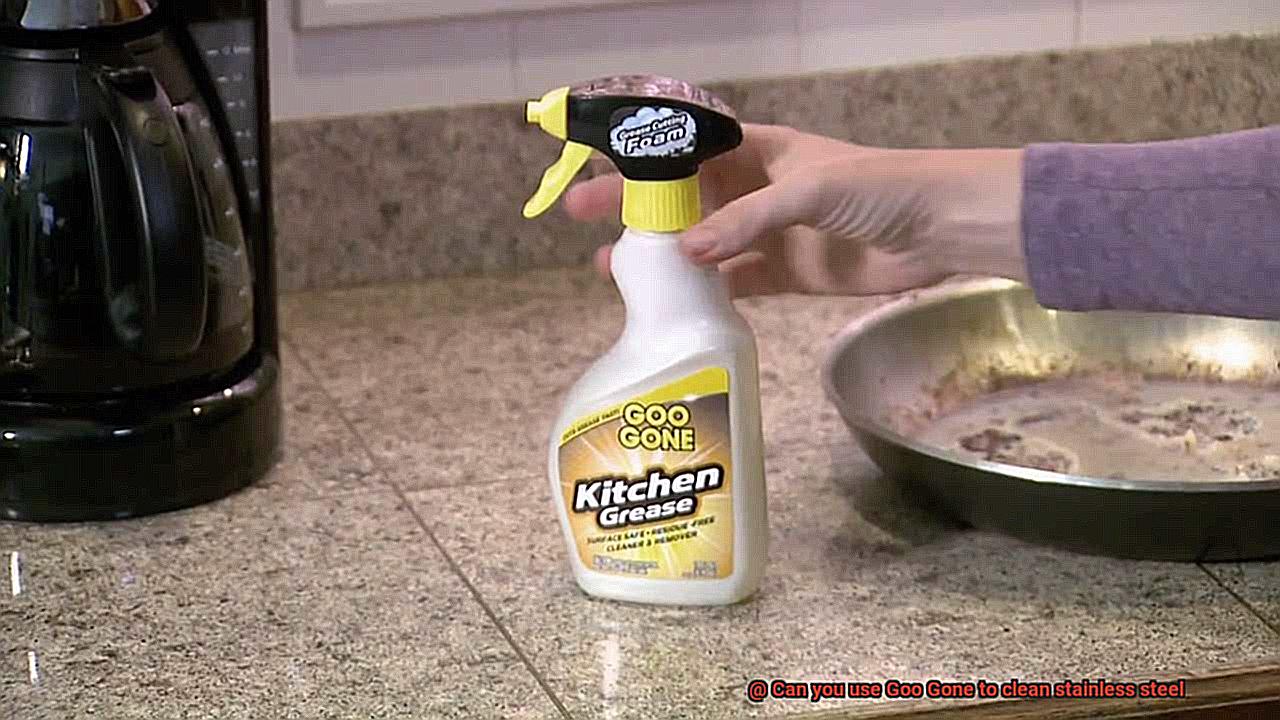
Surfactants are like enchanters that reduce the surface tension of water, enabling it to spread effortlessly into every nook and cranny.
Emulsifiers, on the other hand, are conjurers that blend oil-based substances (like the citrus oil) with water-based substances, rendering them easier to remove.
When these potent ingredients unite their forces, Goo Gone transforms into an unstoppable force. It fearlessly tackles sticky residues on various surfaces, including stainless steel.
But before you unleash this sorcerer on your precious stainless steel surfaces, heed this warning: test Goo Gone on a small, inconspicuous area first. This precaution ensures compatibility and shields against potential damage.
There you have it – the secret behind Goo Gone’s mesmerizing powers unveiled. Its citrus oil, empowered by the solvent might of d-limonene, breaks down and dissolves adhesive, glue, gum, crayon, and more. Bid farewell to sticky messes and welcome a realm of clean and pristine surfaces.
Is it Safe to Use Goo Gone on Stainless Steel Surfaces?

If you’ve ever found yourself locked in battle with stubborn sticky residue on your stainless steel surfaces, fear not. Enter Goo Gone, the enchanting adhesive remover with the power to dissolve even the stickiest of foes. But before you unleash this magical elixir upon your stainless steel kingdom, let’s delve into the realm of safety precautions.
Rest assured, for Goo Gone is generally safe to use on stainless steel surfaces. However, it is wise to conduct a preliminary test on a small, inconspicuous area. This cautious experiment ensures that your stainless steel will not suffer any adverse reactions or damage from the potent powers of Goo Gone.
As you embark upon your quest to banish sticky residue from stainless steel, heed this sage advice: apply Goo Gone directly onto a clean cloth or sponge, rather than spraying it directly onto the surface. By doing so, you maintain control over the amount of product applied and reduce the risk of oversaturation. Armed with your trusty cloth or sponge, gently rub away the adhesive residue with delicate precision.
Avoid the temptation of abrasive materials and scrub brushes. These treacherous villains can inflict unsightly scratches upon your precious stainless steel surface. Instead, stay true to your noble mission and stick to gentle rubbing with a cloth or sponge.
Victory is within reach. Once you have triumphantly removed the adhesive residue with Goo Gone, it is time for a thorough cleansing ritual. Summon warm soapy water and scrub away any lingering remnants of Goo Gone. This purifying act ensures that your surface is pristine and free from any lurking contaminants.
But wait. The quest is not yet complete. After cleansing, take care to dry your stainless steel surface completely. This final act prevents the formation of water spots and streaks, preserving the radiant sheen of your stainless steel domain.
In summary, Goo Gone can be your trusted ally in the battle against adhesive residue on stainless steel surfaces. Just remember to conduct a preliminary test, apply with a cloth or sponge, steer clear of abrasive materials, cleanse with warm soapy water, and dry thoroughly.
Testing Goo Gone on a Small Area of Stainless Steel Surface
In the great battle against sticky residue on our stainless steel fortresses, we turn to the mighty Goo Gone. This powerful adhesive remover is renowned for its ability to conquer even the stickiest foes. But before we unleash this potent elixir upon our stainless steel kingdoms, we must first ensure its safety.
Can Goo Gone be trusted on stainless steel? Fear not, for Goo Gone is generally a safe ally in the war against adhesive residue on stainless steel surfaces. However, prudence dictates that we conduct a preliminary test on a small, inconspicuous area. This cautious experiment ensures that our stainless steel will not suffer any adverse reactions or damage from Goo Gone’s mighty powers.
So how do we proceed with testing Goo Gone on a small area of stainless steel surface? Let us embark on this journey step by step:
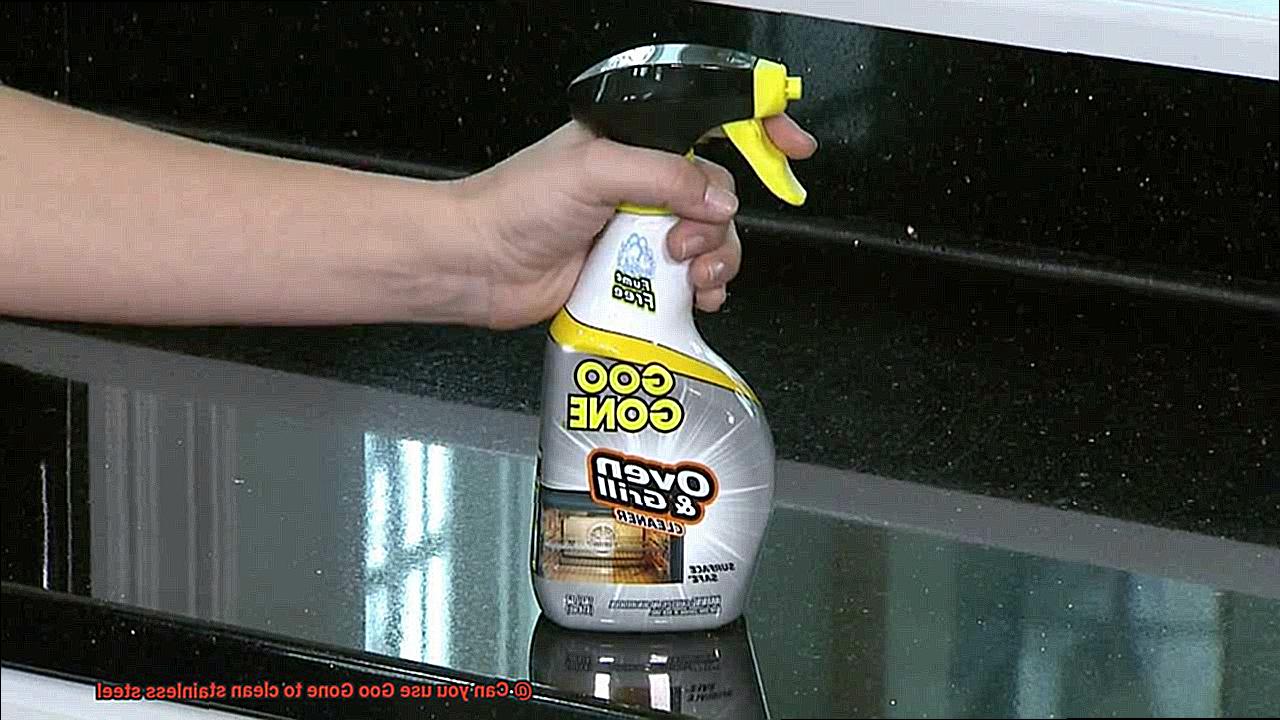
Choose a small inconspicuous area of the stainless steel surface as our testing ground. The back or underside of an appliance or utensil will serve us well.
Prepare the battlefield by cleaning the chosen area with a gentle soap and water solution. This will eliminate any dirt or grime that may impede our test.
Here comes the crucial moment – apply a small amount of Goo Gone onto a clean, soft cloth or sponge. Remember, abrasive materials such as scrub brushes or steel wool must be avoided to prevent unsightly scratches on our precious stainless steel.
With a gentle touch, rub the Goo Gone onto the selected area in circular motions. We must exercise caution and refrain from applying excessive pressure, as it could mar the surface.
Allow the magic of Goo Gone to work its wonders by letting it sit on the stainless steel for a few minutes. During this time, it will penetrate and dissolve any adhesive residue with its enchanting powers.
As the waiting period concludes, take a clean cloth or sponge dampened with warm water and wipe away the Goo Gone and residue.
Now, our vigilant eye must inspect the test area closely for any signs of damage. Scratches or discoloration must be noted. If no harm is detected, we can confidently proceed to use Goo Gone on the rest of the stainless steel surface.
However, if any negative effects come to light during our inspection, it would be wise to reconsider and explore alternative cleaning methods rather than subjecting our stainless steel to further harm.
Steps for Cleaning Stainless Steel with Goo Gone
Stainless steel surfaces can be a magnet for sticky residue and stubborn stains, but fear not. With the power of Goo Gone, you can easily restore your stainless steel to its gleaming glory.
As an expert in the field, I’m here to provide you with a step-by-step guide on how to effectively clean stainless steel using this remarkable adhesive remover.
Get ready to witness the transformation as we embark on this cleaning journey together.
Step 1: Read the Label – Choose Wisely
Before embarking on your stainless steel cleaning mission, take a moment to read the label on your Goo Gone bottle. Ensure that it is specifically designed for use on stainless steel surfaces. Different Goo Gone products cater to different materials, so selecting the appropriate one is crucial for success.
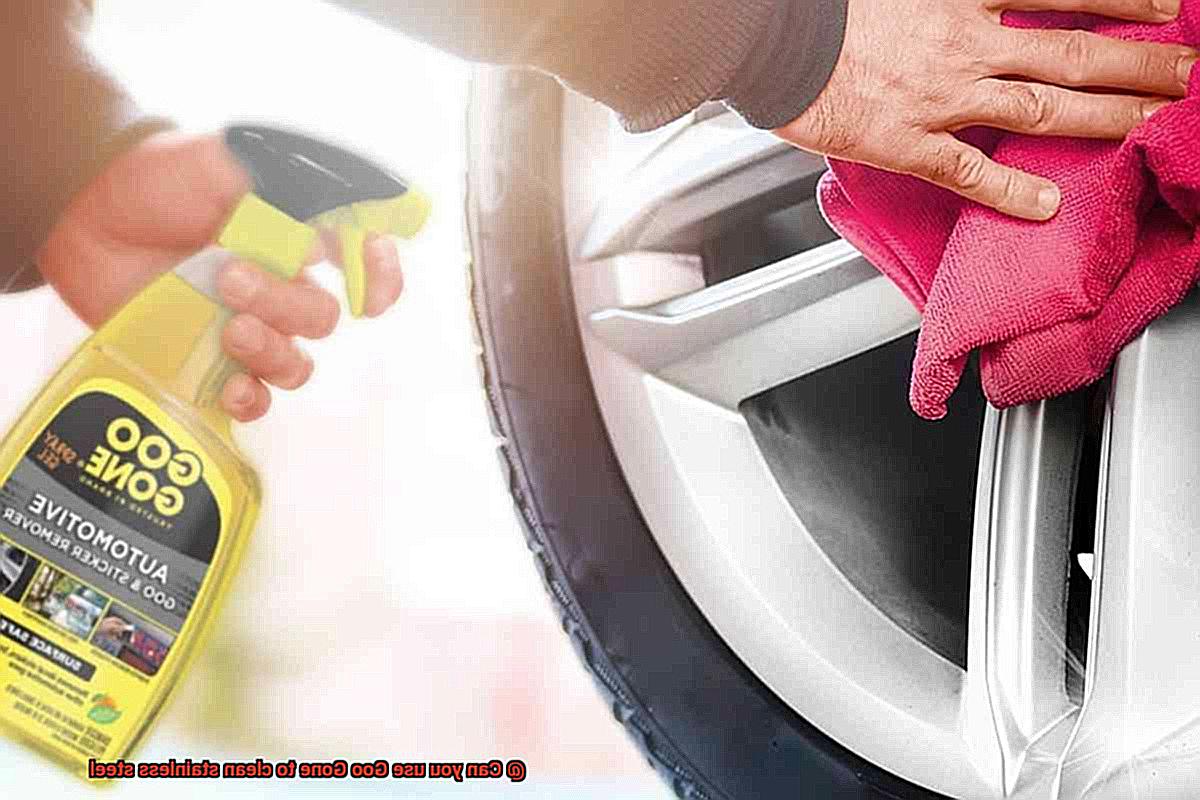
Step 2: Prepare the Surface – The Crucial First Step
Prepare your stainless steel surface for cleaning by removing any loose dirt or debris. Pamper it with a gentle wipe using a soft cloth or a delicate brush, ensuring that you won’t cause any scratches while tackling those tough stains.
Step 3: Apply Goo Gone – Unleash the Power
It’s time to unleash the power of Goo Gone. Apply a small amount of this miracle solution onto a clean, soft cloth or sponge. Remember, avoid pouring it directly onto the stainless steel surface to prevent excessive dripping or spreading.
Step 4: Gentle Rubbing – A Dance of Delicacy
With grace and finesse, gently rub the cloth or sponge onto the stained areas of your stainless steel surface. Employ circular motions to ensure thorough cleaning, but be cautious not to exert too much pressure that may lead to unwanted scratches or damage.
Step 5: Let It Sit – The Magic Unfolds
Allow Goo Gone to work its enchantment by letting it sit on the stainless steel for a few minutes. During this time, the solution will diligently break down and dissolve the most stubborn adhesive residue or stains.
Step 6: Wipe Away – Bid Farewell to Residue
After patiently waiting, grab a clean, damp cloth and bid farewell to both Goo Gone and the residue it has conquered. Be sure to rinse the cloth regularly to prevent any residue from making a sneaky comeback onto the surface.
Tips for Using Goo Gone on Stainless Steel Surfaces

Stainless steel surfaces add a touch of elegance and sophistication to any space, but when sticky residues or adhesives cling to them, it can be quite frustrating.
Luckily, Goo Gone is here to save the day. As a powerful adhesive remover, Goo Gone can tackle even the most stubborn messes.
However, to ensure a safe and effective cleaning process, it’s important to follow these tips when using Goo Gone on stainless steel surfaces:
Test it First
Before diving in and applying Goo Gone all over your stainless steel surface, take a moment to test it on a small, inconspicuous area. This precautionary step will allow you to check for any adverse reactions or discoloration. Just apply a small amount of Goo Gone and patiently observe for a few minutes before wiping it away.
Read and Follow Instructions
Different formulations of Goo Gone may come with specific instructions for using the product on stainless steel surfaces. To achieve optimal results, make sure to read and carefully follow the instructions provided on the product label. This will ensure that you are using the product correctly and getting the best possible outcome.
Remove Loose Debris
Preparation is key when it comes to using Goo Gone on stainless steel surfaces. Before applying the adhesive remover, take the time to remove any loose debris or dirt from the surface. A soft cloth or sponge dampened with warm water and mild dish soap can work wonders in gently cleaning the surface before treatment.
Apply with Care
When it’s time to apply Goo Gone, exercise caution and precision. Instead of directly applying it onto the stainless steel surface, put a small amount onto a clean, soft cloth or sponge. This method helps prevent streaks and discoloration that may occur when Goo Gone is applied directly onto the surface.
Gentle Circular Motion: Now comes the fun part
removing the adhesive residue. Gently rub the Goo Gone onto the adhesive residue in a circular motion. This gentle circular motion allows the product to penetrate the residue and makes it easier to remove. Remember to avoid using excessive pressure or abrasive materials that can potentially scratch or damage the stainless steel surface.
Thoroughly Rinse and Dry
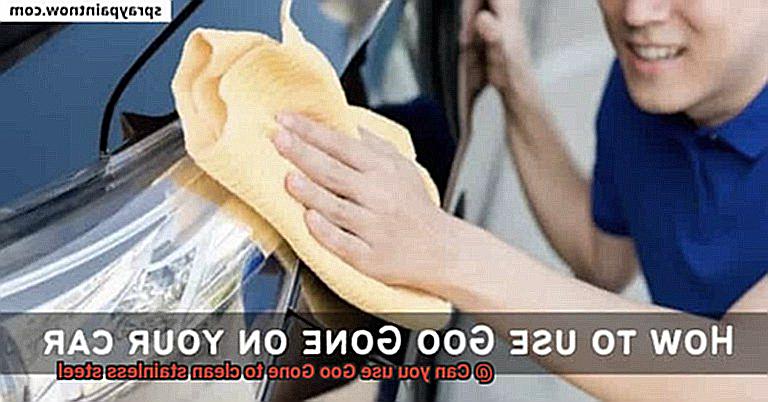
Once you have successfully removed the adhesive residue, it’s crucial to thoroughly rinse the stainless steel surface with warm water and mild dish soap. This step ensures that any remaining Goo Gone is completely removed, preventing any potential damage. After rinsing, take a clean, soft cloth and diligently dry the surface to prevent any water spots or streaks from forming.
Potential Damage to Stainless Steel from Using Goo Gone
Imagine the satisfaction of effortlessly removing sticky residue from your stainless steel surfaces with the help of Goo Gone, the adhesive remover superhero. But beware, for beneath its powerful cleaning prowess lies the potential for damage to your cherished stainless steel. As an expert in this field, I am here to enlighten you about the risks involved and provide invaluable tips to safeguard your stainless steel. Prepare to dive into a world where caution is key.
The Discoloration Dilemma:
Let’s start with the first peril of using Goo Gone on stainless steel: surface discoloration. This adhesive remover boasts potent solvents capable of stripping away the protective coating on stainless steel, leaving behind a lackluster and discolored appearance. Your once gleaming appliances may transform into unsightly eyesores due to one cleaning misstep.
Pitting and Etching Concerns:
Discoloration is not the only danger lurking when using Goo Gone on stainless steel. It can also lead to pitting or etching on the surface. The powerful solvents in this product have the ability to corrode or erode the metal over time, resulting in small pits and rough spots. Such compromises jeopardize the integrity of your stainless steel, making it more susceptible to further harm.
Factors Affecting Damage Severity:
The severity of damage caused by Goo Gone depends on various factors. The type and quality of your stainless steel, the duration of exposure to the product, and even the concentration of solvents in Goo Gone all play a role. Remember that even a fleeting encounter with this adhesive remover can potentially harm your stainless steel, so vigilance is paramount.
Precautions for Safe Usage:
To minimize the risk of damage when using Goo Gone on stainless steel, adhere to these essential precautions:
- Test it First: Before applying Goo Gone to larger surfaces, conduct a small-scale compatibility test on an inconspicuous area. This simple step enables you to gauge its impact on your specific stainless steel material.
- Gentle Application: Employ a soft cloth or sponge when gently applying Goo Gone to the stain or adhesive residue. Avoid abrasive materials and harsh scrubbing motions that could exacerbate the damage. Allow the product to work its magic for a short period before delicately wiping it off with a clean cloth.
Alternative Cleaning Methods for Stainless Steel
Stainless steel possesses a timeless allure, but its beauty can fade if not treated with the proper care. While Goo Gone is a master at removing adhesives, it falls short in the realm of stainless steel cleaning. Prepare to embark on a journey where we explore alternative methods that will restore your stainless steel treasures to their former glory. Say goodbye to dirt, grease, and fingerprints as we unveil these simple yet effective techniques.
Warm Water and Mild Dish Soap:
Simplicity often holds the key to brilliance. Begin by filling a sink or bucket with warm water and adding a small amount of mild dish soap. Immerse a soft cloth or sponge into the soapy solution and gently cleanse the stainless steel, paying extra attention to areas with stubborn stains.
Rinse the cloth or sponge regularly and continue until the surface is pristine. Finally, use a clean, lint-free cloth to dry the stainless steel, leaving no room for water spots to mar its radiance.
Vinegar:
Embrace the power of nature with vinegar as your trusted ally. Dilute vinegar with an equal amount of water and transfer the mixture to a spray bottle. Spritz the solution onto the stainless steel surface, allowing it to work its magic for a few minutes. Employ a soft cloth or sponge to wipe away the vinegar solution, moving in harmony with the grain of the stainless steel. For stubborn stains, employ a gentle-bristled brush to delicately scrub away the blemishes. Conclude this ritual by rinsing with water and meticulously drying every inch.
Commercial Stainless Steel Cleaners:
For those who crave convenience, commercial stainless steel cleaners offer a tailored solution. These specialized products come in spray or wipe form, armed with the ability to obliterate dirt, fingerprints, and smudges while bestowing upon your stainless steel a protective shield. Simply follow the manufacturer’s instructions to unlock sparkling results with minimal effort.
Microfiber Cloth:
Irrespective of your chosen cleaning method, the presence of a microfiber cloth is non-negotiable. These gentle and lint-free fabrics treat stainless steel surfaces with reverence, preventing scratches and streaks from sullying their flawless appearance. Remember to honor the grain of the stainless steel as you clean, ensuring a seamless finish that reflects true perfection.
JQz5-VXRYOs” >
Conclusion
Goo Gone, a trusted and versatile cleaning product, is indeed suitable for cleaning stainless steel surfaces.
Its powerful formula effectively removes tough stains, sticky residue, and adhesive marks without causing any damage to the stainless steel finish. With just a few simple steps, you can restore your stainless steel appliances, fixtures, and utensils to their original shine and brilliance.
Goo Gone effortlessly cuts through grease, grime, and fingerprints, leaving behind a spotless surface that gleams with perfection.

